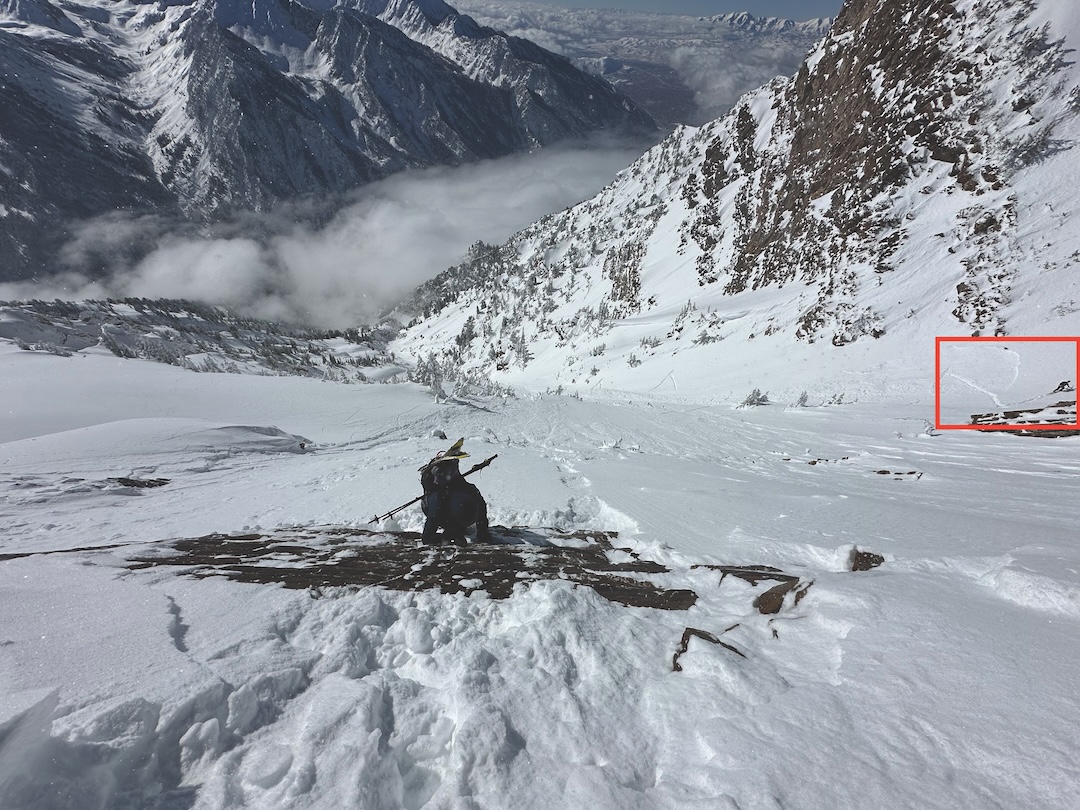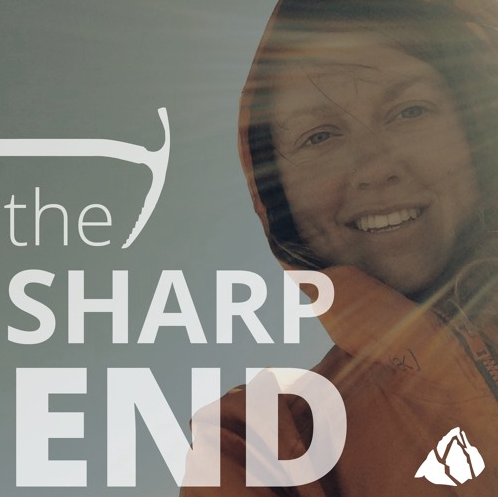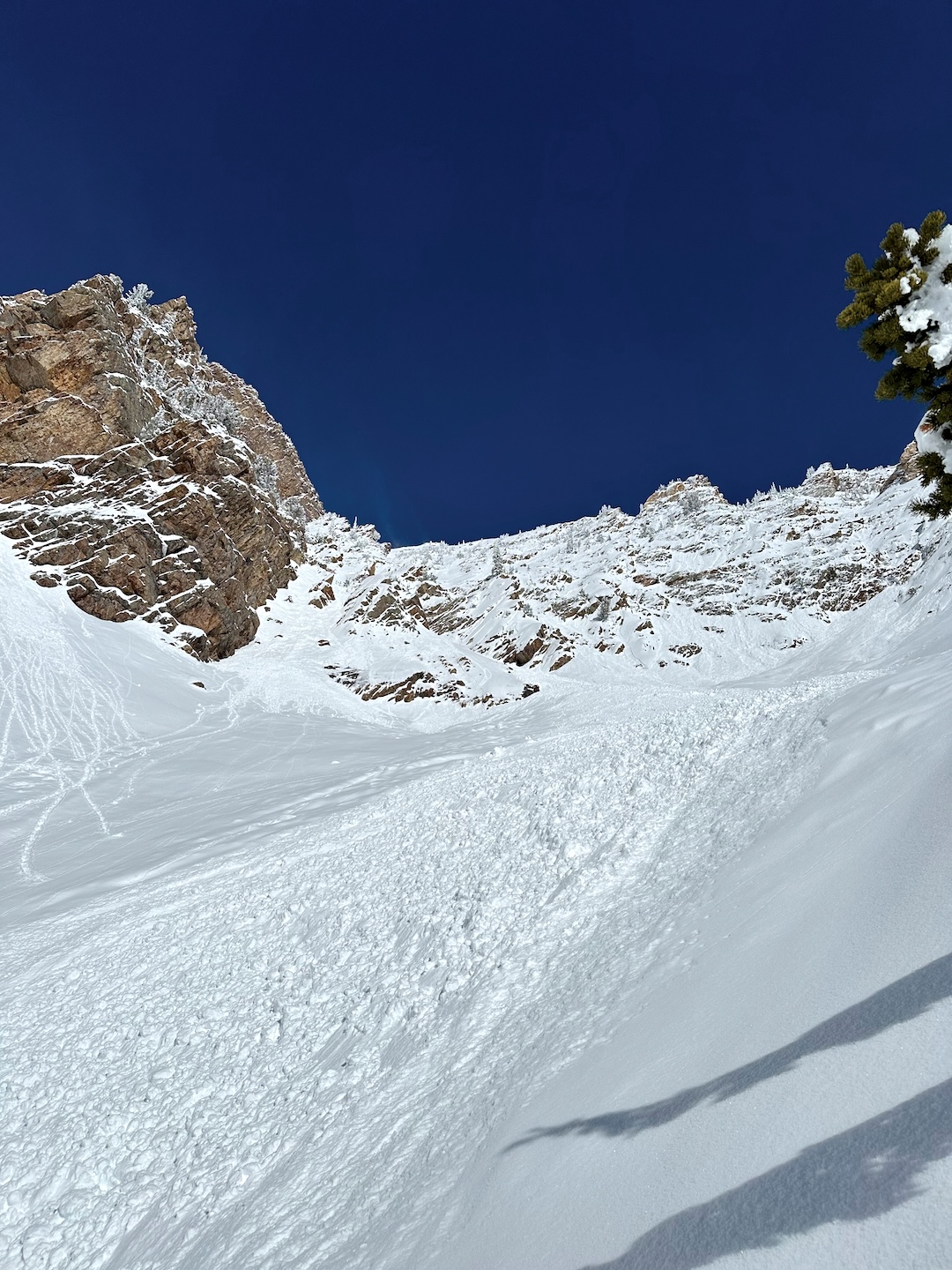Multiple Avalanches
Utah, Wasatch Mountains, Twin Peaks

On February 11, two parties of backcountry skiers were involved in a serious accident while attempting to summit Twin Peaks (11,330 feet) in the central Wasatch. Group A (a party of three) set off from the Mill B trailhead in Big Cottonwood Canyon at 9 a.m. Their objective was an ascent of Broads Fork to the back of the drainage, gaining the east ridge of Twin Peaks, summiting, and then skiing down the west face.
When Group A arrived in the upper reaches of Broads Fork, they found themselves breaking trail to the back of the basin. As they approached the far wall of the drainage, they realized a solo skier (Skier 1) had been following their track. Skier 1 had begun his approach via the same route, planning to assess conditions on runs lower in Broads Fork. But instead he toured past those runs and followed Group A higher up the canyon.
Upon reaching upper Broads Fork, Group A focused on their ascent to the ridge. They navigated what they thought to be the most hazardous section: a short pitch of north-facing alpine terrain. With two of the three skiers in a safe spot, the leader broke trail to the ridge. During the ascent, Skier 1 considered chatting with Group A, but never got close enough to talk about their tour and descent plans.
On the ridge, Group A found very sensitive wind slabs on the leeward (south) side of the ridge. They actively mitigated very small wind pillows of snow, noting the hazard. It was then that Skier 1 also gained the ridge. He also noted the wind loading but decided he could manage it. Group A watched Skier 1 leave the ridge and enter the south-facing terrain. Skier 1 skinned down and across the slope on the leeward side below the ridge.
Skier 1 traversed into Lisa Falls, a popular south-facing 5,000-foot run. Upon entering this consequential terrain, Skier 1 triggered a small wind slab, was caught, and was carried for 200 feet. He pulled an airbag, recovered, and tried to quickly descend out of the avalanche path. At this point, Group A lost sight of Skier 1. Out of their sight, another avalanche released above Skier 1, carrying him another 1,000 feet.
After moving farther along the ridge, members of Group A saw that Skier 1 had triggered the larger avalanche and been flushed out of sight. A member of Group A (Skier A) saw a way to access the avalanche’s crown and track, thus staying out of hangfire, and then descend the slide path to try to make visual or verbal contact with Skier 1. After a short downclimb and approximately 500 feet of ski descent, they were able to see Skier 1’s airbag. Skier 1 was injured and requested help.
Skier A was able to communicate to his party that he would continue another 500 vertical feet to Skier 1. Group A called 911 from the ridge. Through patchy cell service, Skier A communicated that both he and Skier 1 needed a helicopter rescue. Skier 1 had internal injuries, and Skier A could not safely extricate himself due to the overhead hazard caused by warming and wind loading in extreme terrain. Skier A warmed and packaged Skier 1. They were both hoisted off the mountain by the Utah Department of Public Safety.
ANALYSIS
The avalanche started small but entrained a large volume of snow. By the time it stopped, it was a destructive D2.5 avalanche. Skier 1 was very lucky to survive. He suffered a hemothorax, many broken ribs, and broken facial bones.
The weather and snowpack leading up to the incident were fairly normal for early-to-mid-season Utah. The Wasatch had a lingering persistent weak layer on the northwest through southeast aspects of the compass, at the middle and upper elevations. Beginning on February 1, the range had received 4.5 to 6 feet of snow.
Overnight, the mountains had received another six inches of snow; winds were generally light, with an occasional gust into the 30s along the highest ridgelines. The avalanche hazard was rated considerable on northwest through southeast aspects in the mid- and upper elevations, and moderate elsewhere.
Group A was aware there was a persistent weak layer on much of the north side of the compass. They also knew that south-facing terrain was sunny and wind-loaded. They planned to only travel through one small section of north-facing terrain to access the ridge and then descend a mostly west-facing, windward slope. The skiers in Group A were mountain guides and medical professionals. Their skills played into facilitating the rescue. Though well equipped, they did not have radios, which would have made ridge-to-patient communication easier.
Skier 1 had a more ambiguous travel plan, going into the day with different options. He was excited about the day’s clear skies and new snow. Ultimately, this mindset lured him into the upper reaches of Broads Fork and onto Twin Peaks. Then, because of a scarcity or “powder panic” mindset, he decided to drop into sunny and untracked terrain.
If Skier 1 had a strict tour plan matching the forecast, he might have stayed out of harm’s way. He may have skied terrain better suited for solo skiing, as well as avoiding the alpine and wind-loaded slopes.
The biggest takeaway is the need for strong communication. Because of the terrain and the pace, an easy opportunity for the two parties to communicate never presented itself. There was never a conversation about respective plans and how those plans might benefit from collaboration versus competition. If an individual arrives to a run and another party is already there, it is the former’s responsibility to attempt communication or find a different place to ski.
Extended dry spells followed by big loading events create a dangerous snowpack and dangerous mindsets. Increasingly, we are seeing complex and persistent avalanche problems, along with more people trying to ski fresh snow when storms finally arrive. A growing number of skiers are crowding finite terrain. In these scenarios, planning, patience, and improved communication—both within parties and with others—are ever more important. (Sources: Skier A, Skier 1, and the Editors.)


